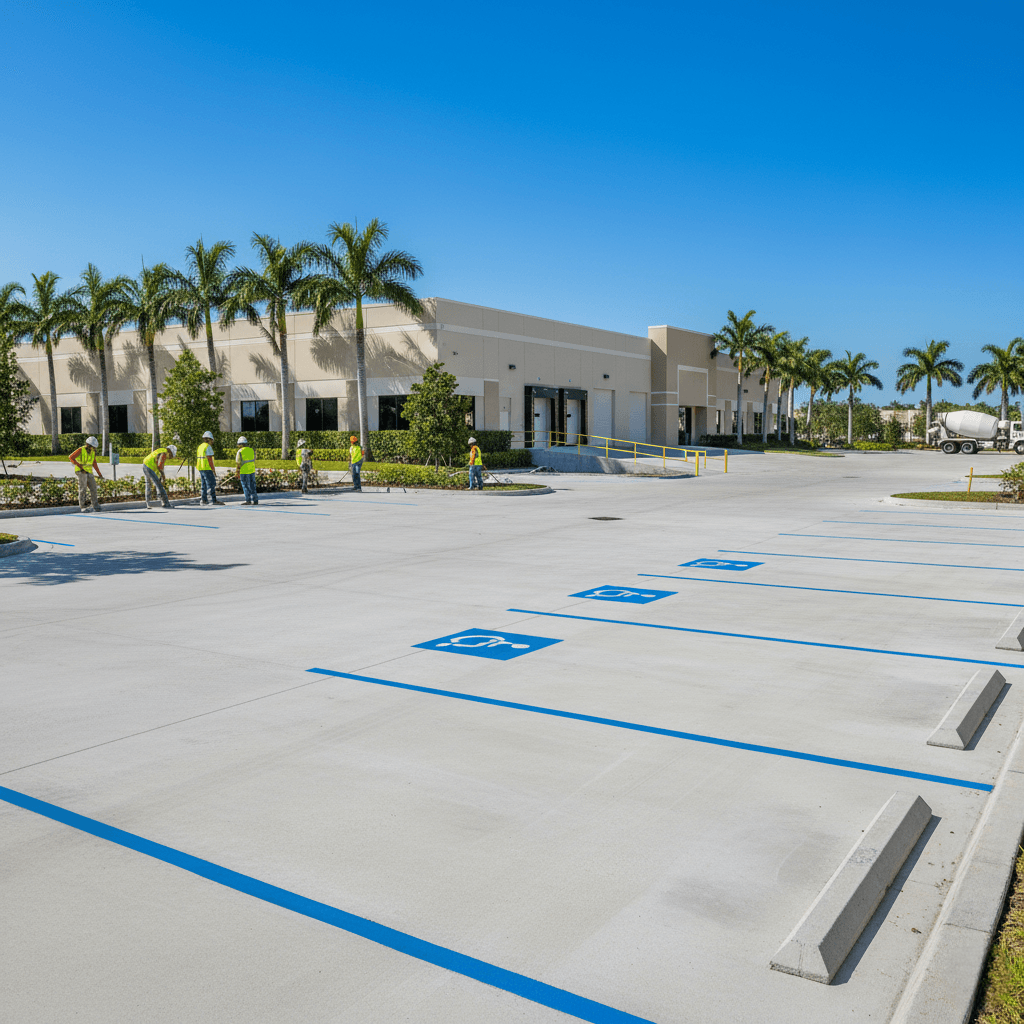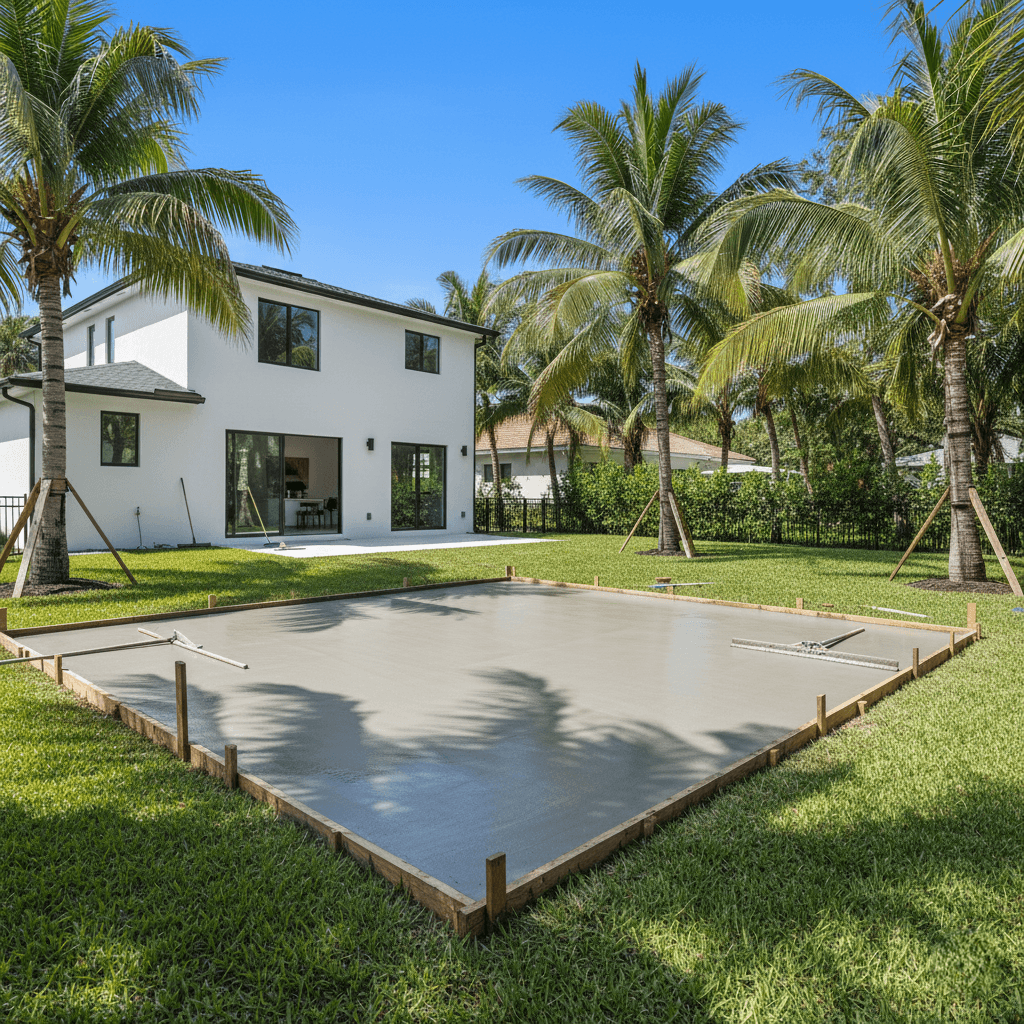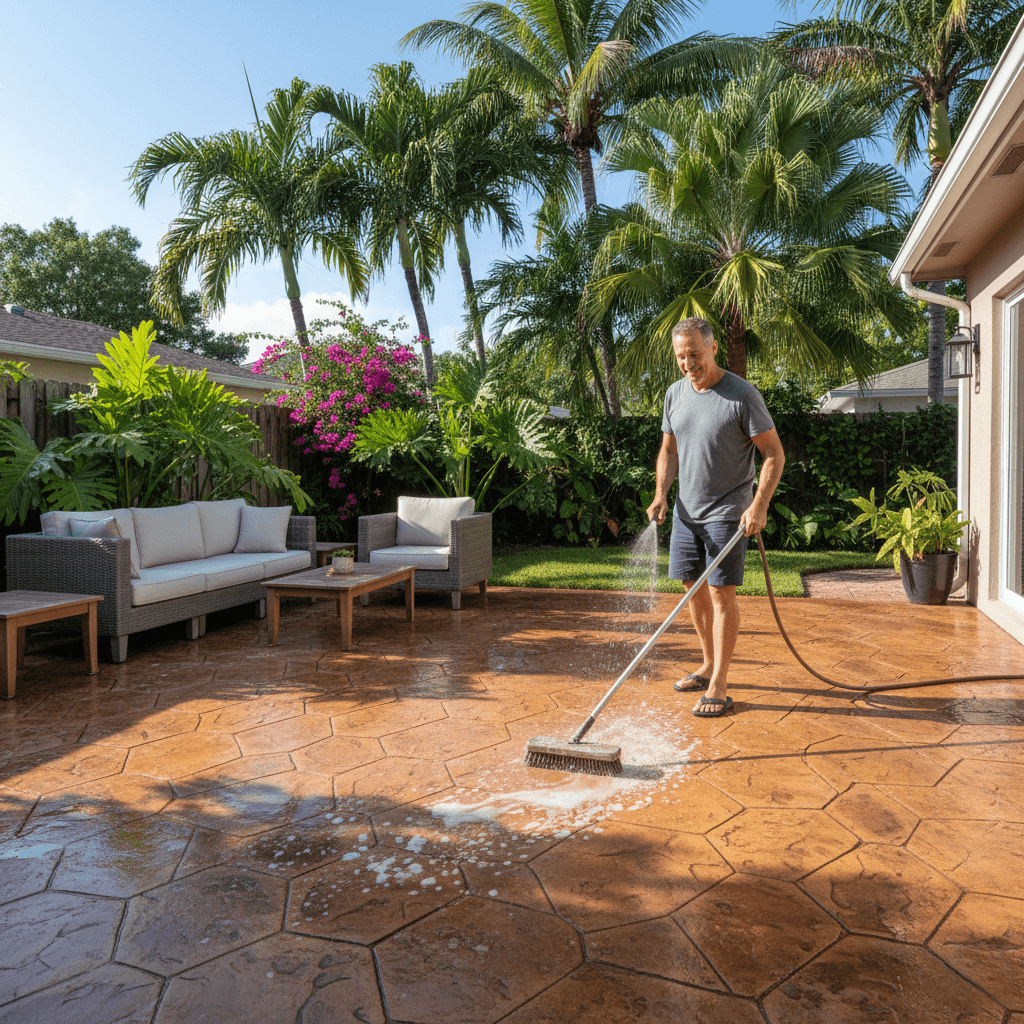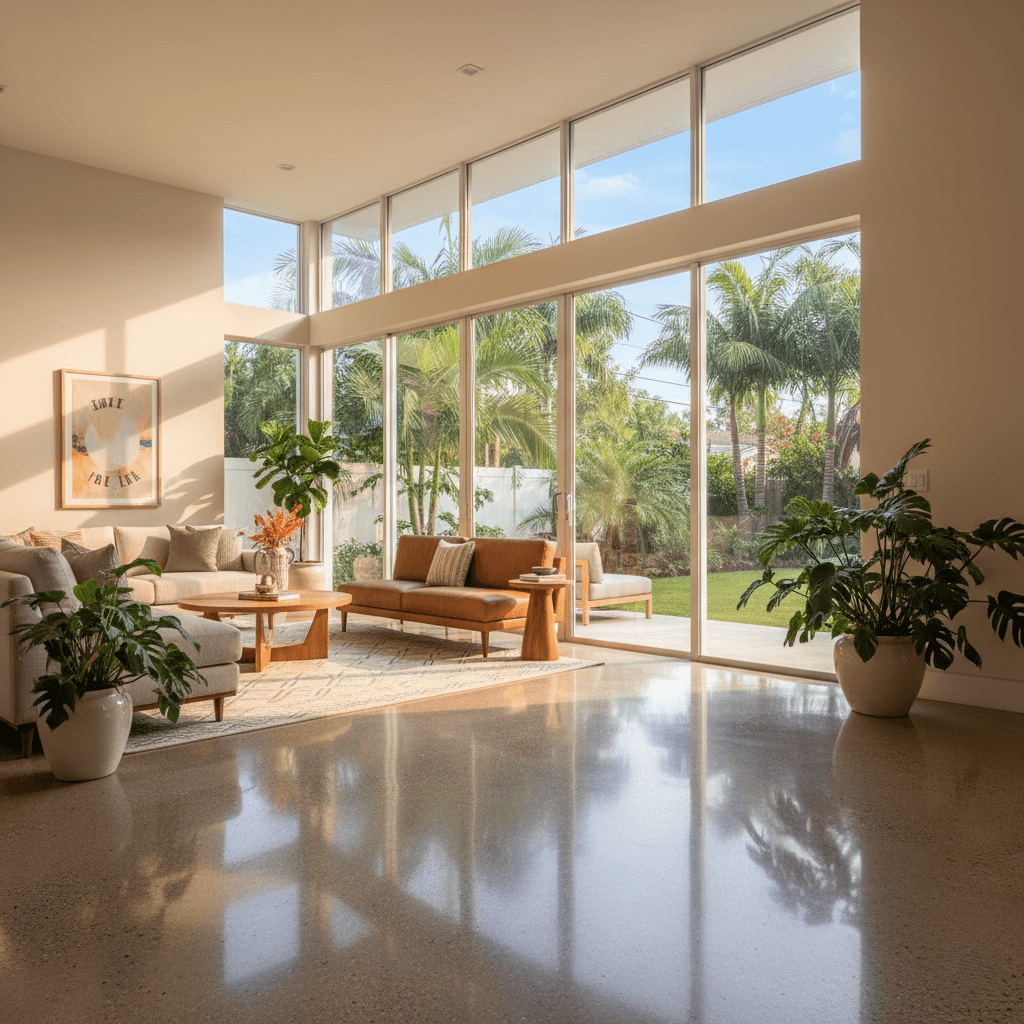
Step-by-Step Concrete Patio Installation in Miami Gardens
Concrete Patio Miami Gardens
Creating an outdoor living space that extends your home’s functionality requires careful planning and proper execution. A well-constructed concrete patio provides years of reliable service while enhancing property value and creating the perfect setting for family gatherings, outdoor dining, or quiet relaxation. Understanding the installation process helps homeowners make informed decisions and ensures project success. Whether you plan to tackle aspects of the work yourself or hire professionals, knowing each step from initial planning through final finishing empowers you to achieve outstanding results that withstand South Florida’s unique climate conditions.

Planning Your Concrete Patio Project
Successful installations begin with thorough planning that addresses size, location, design elements, and budget considerations. Start by evaluating how you intend to use your outdoor space. Families who enjoy entertaining large groups need more square footage than those seeking a quiet morning coffee spot. Most residential patios range from 12 by 12 feet for intimate spaces to 20 by 20 feet or larger for expansive entertaining areas.
Location selection significantly impacts both functionality and longevity. Choose areas with adequate sun exposure for drying after Miami Gardens’ frequent rainfall while considering shade placement during hot afternoon hours. Properties near Rolling Oaks or throughout the Vista Verde community benefit from positioning patios to capture prevailing breezes while avoiding direct western sun exposure. Proximity to your home’s entrance matters for convenience, but maintain a proper distance from the foundation to prevent water damage issues.
Permit Requirements and Building Codes
Miami Gardens enforces specific regulations governing concrete patio construction. Contact the Building Services Division before beginning work to determine whether your project requires permits. Most residential patios need approval to ensure compliance with setback requirements, drainage specifications, and structural standards. The permit process typically takes several business days, so factor this timeline into your project schedule. Working without proper authorization creates complications, including fines and potential removal requirements.
Site Preparation and Excavation
Proper foundation work determines patio performance for decades. Begin by marking your planned patio boundaries using stakes and string lines. Create layout lines 18 inches beyond your finished dimensions to provide adequate working space during construction. Verify that corners form perfect right angles using the three-four-five triangle method, measuring three feet along one side, four feet along the adjacent side, and confirming the diagonal measures exactly five feet.
Excavation depth depends on your total slab thickness and base requirements. Most installations need the removal of six to eight inches of soil to accommodate an inch of compacted gravel base plus four inches of concrete. Clear all vegetation, roots, and organic material from the excavation area. Organic matter decomposes over time, creating voids that cause settling and cracking. Use a plate compactor to firm the exposed soil, creating a stable foundation that resists shifting.
Addressing Miami Gardens Soil Conditions
South Florida soil composition varies considerably, with many areas containing high clay content or sandy conditions. Clay soils expand and contract with moisture changes, potentially causing concrete movement. Sandy soils drain well but may lack adequate support. Consider testing soil conditions in areas like Lake Lucerne or near NW 183rd Street to identify any amendments needed. Poor soil may require additional base depth or specialized stabilization techniques.
Installing the Base and Drainage Systems
A properly constructed base provides essential support and drainage capabilities. Spread crushed stone or gravel in two-inch layers, compacting each thoroughly before adding the next. This layering approach ensures uniform density throughout the base. Continue until you achieve a four-inch compacted depth. Quality compaction prevents future settling that leads to cracking and uneven surfaces.
Miami Gardens receives significant rainfall, particularly during the summer months, making drainage planning critical. Your patio must slope away from structures at a minimum rate of one-quarter inch per foot. This gradient encourages water runoff while remaining imperceptible to users. For a ten-foot patio projecting from your home, the outer edge should sit two and a half inches lower than the point where it meets the house. Properties throughout Bunche Park or near the Palmetto Expressway corridor may require additional drainage considerations based on the surrounding grade and water flow patterns.
Building and Setting Forms
Forms create the framework that contains concrete during pouring and establishes the finished patio dimensions. Use straight lumber such as two-by-fours or two-by-sixes, selecting boards without excessive warping or damage. Assemble forms around your excavated area perimeter, securing corners with deck screws. Drive wooden stakes every two feet along form boards to maintain position during concrete placement.
Level verification ensures professional results. Use a four-foot level or laser level to check that form tops align properly while maintaining proper slope for drainage. The high point typically sits against your home, with forms gradually lowering as they extend outward. Once positioning satisfies you, cut stakes flush with form tops. Any protruding stakes interfere with screeding operations during finishing. Apply release agent to form interiors for easier removal after the concrete cures.
Reinforcement Placement
Steel reinforcement significantly enhances concrete strength and crack resistance. Standard residential patios use wire mesh or rebar positioned in the lower third of the slab thickness. For four-inch concrete, place reinforcement approximately one and a half inches above the base. Support mesh or rebar on small concrete blocks or commercial chair supports rather than laying it directly on gravel. Proper elevation ensures reinforcement sits within the concrete rather than resting on the base, where it provides minimal benefit.
Mixing and Pouring Concrete
Quality concrete requires correct proportions of cement, aggregate, sand, and water. For residential patios in South Florida, specify a minimum 4,000 PSI compressive strength concrete. This specification ensures adequate durability for the humid climate and typical usage demands. Ready-mix delivery proves most practical for patios exceeding one cubic yard, typically any area larger than approximately 80 square feet at four-inch thickness.
Schedule concrete delivery for cooler morning hours when possible. Miami Gardens temperatures often exceed 90 degrees by midday, causing rapid moisture evaporation that compromises curing. Arrange adequate help before delivery arrives, as concrete placement moves quickly once trucks begin pouring. Direct concrete into forms systematically, working from one end toward the other. Use shovels to spread material evenly, eliminating air pockets and ensuring consistent thickness throughout.
Screeding and Initial Finishing
Immediately after placement, strike off excess concrete using a straight board spanning across form tops. This screeding process levels the surface and removes high spots. Work the screed board along forms using a sawing motion, making at least two complete passes. Two people make this task considerably easier, particularly on wider patios. Add extra concrete to low areas and continue screeding until achieving a uniform height across the entire surface.
Following screeding, use a bull float for initial smoothing on larger patios or a hand float on smaller areas. Float the surface using overlapping arcs followed by straight side-to-side strokes. This process embeds large aggregate particles slightly below the surface while bringing finer materials upward, creating a smoother finish. Floating also helps eliminate minor irregularities left by screeding operations. Properties near the Norland neighborhood or throughout Scott Lake benefit from this critical step that establishes a foundation for final finishing work.
Creating Control Joints and Final Finishing
Control joints manage inevitable concrete cracking by providing predetermined weak points where cracks form in straight lines rather than random patterns. Install joints while concrete remains workable, typically within the first few hours after placement. Space joints approximately eight to ten feet apart in both directions, creating square or rectangular sections. Use a jointing tool guided by a straight board to cut grooves one-quarter of the slab depth.
Wait for surface water to disappear before final finishing. Premature finishing traps excess moisture near the surface, weakening concrete and causing scaling problems. Once the water sheen evaporates but the concrete remains plastic, run an edging tool along all form edges to round corners and reduce chipping potential. Apply your chosen surface texture using appropriate tools. Broom finishes provide excellent traction and prove easiest for beginners, created by dragging a soft-bristle broom across the surface in straight lines or gentle arcs.
Finishing Considerations for the Florida Climate
South Florida’s intense sun and humidity require special attention during finishing. Work efficiently to complete operations before the concrete hardens excessively. Consider using evaporation retardants on particularly hot or windy days. These spray-applied products slow surface drying, providing additional working time for finishing operations. Neighborhoods throughout Carol City or near Hard Rock Stadium may experience varying microclimates that affect concrete behavior during placement and finishing.
Curing and Protection
Proper curing represents the most critical post-installation phase, directly impacting final concrete strength and durability. Concrete continues hardening for weeks after placement, but the first seven days prove most crucial. Maintain adequate moisture during this period by applying the curing compound immediately after finishing. These liquid products form a membrane that slows moisture evaporation, allowing proper hydration of cement particles.
Alternatively, cover the patio with plastic sheeting, though this method may leave slight surface discoloration. Another option involves keeping the surface continuously damp through periodic misting with a garden hose. This approach requires diligent attention but produces excellent results. Regardless of the method chosen, prevent the concrete from drying too quickly. Rapid moisture loss causes surface crazing, reduced strength, and increased vulnerability to cracking. Protect newly placed concrete from foot traffic, heavy objects, and rain for at least 48 hours.
Form Removal and Joint Sealing
Remove forms after concrete achieves sufficient strength, typically 24 to 48 hours after placement, depending on weather conditions. Carefully pry forms away from concrete edges to avoid chipping corners. Fill any minor edge imperfections with patching compound if necessary. Inspect control joints and expansion gaps, cleaning out any debris or loose material.
Seal control joints with flexible joint sealant to prevent dirt accumulation and weed growth. These products remain pliable, accommodating concrete movement without cracking. Proper joint sealing extends patio lifespan and maintains a clean appearance. Consider applying concrete sealer after the full 28-day curing period to protect against staining and moisture penetration. Sealers prove particularly valuable in humid climates where moisture-related damage poses ongoing concerns.
Post-Installation Care and Maintenance
Avoid placing heavy furniture or equipment on your new patio for at least seven days. Concrete continues gaining strength during this period, and premature loading may cause surface damage or cracking. Once fully cured, your concrete patio requires minimal maintenance beyond periodic cleaning and resealing every two to three years. Sweep regularly to remove dirt and debris. Clean stains promptly using appropriate products for the stain type.
Pressure washing removes accumulated grime and organic growth, but avoid excessive pressure that damages the surface. Monitor for cracks or deterioration, addressing minor issues promptly before they worsen. Reapply sealer according to manufacturer recommendations to maintain protection against moisture and staining. Proper care ensures your patio remains attractive and functional for decades, providing countless hours of outdoor enjoyment.
Professional Installation Benefits
While understanding installation processes proves valuable, professional contractors bring expertise, equipment, and efficiency that ensure superior results. Licensed professionals working throughout Miami Gardens possess specialized knowledge about local soil conditions, drainage requirements, and climate considerations. They maintain relationships with quality concrete suppliers, access commercial-grade equipment, and carry insurance protecting homeowners from liability.
Professional installation typically proceeds faster than DIY approaches, minimizing disruption to your property and daily routine. Experienced crews anticipate potential problems and implement solutions proactively. They guarantee their workmanship, providing recourse if issues develop. These advantages often outweigh cost differences between DIY and professional installation, particularly for larger or more complex projects.
Achieving Your Ideal Outdoor Space
A properly installed concrete patio transforms outdoor living, creating a versatile space for relaxation, entertainment, and family activities. Following proven installation procedures ensures your patio withstands Miami Gardens’ climate challenges while delivering years of reliable service. Whether you choose professional installation or tackle portions yourself, understanding each step from planning through finishing empowers you to achieve excellent results.
At Miami Gardens Concrete Pros, we specialize in professional concrete patio installations that combine technical expertise with attention to design details. Our experienced team handles every aspect of the process, from initial site evaluation and permit acquisition through final finishing and sealing. We understand South Florida’s unique requirements and use proven techniques that deliver exceptional durability and appearance. From simple rectangular designs to custom shapes incorporating decorative elements, we create outdoor spaces that enhance your property and lifestyle.



